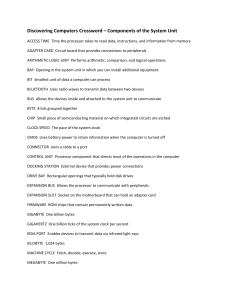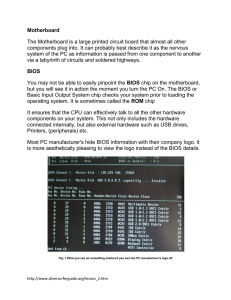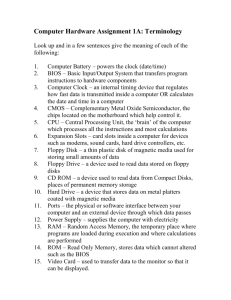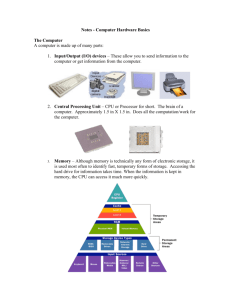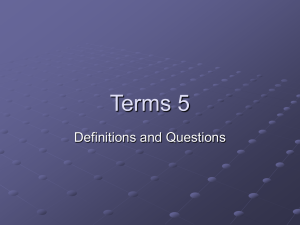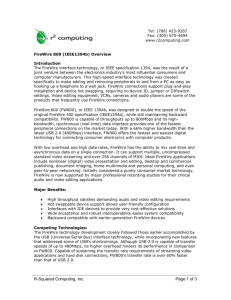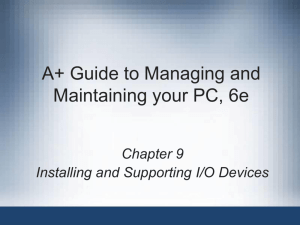Anatomy of a Computer: Key Components Explained
advertisement
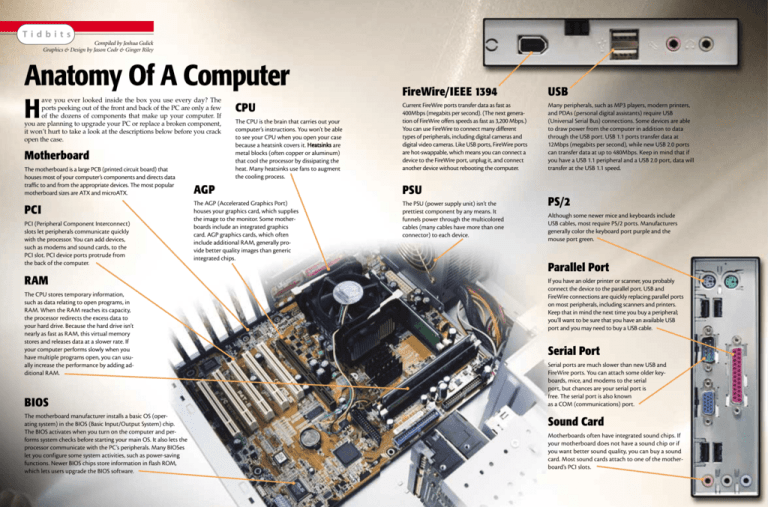
Tidbits Compiled by Joshua Gulick Graphics & Design by Jason Codr & Ginger Riley Anatomy Of A Computer ave you ever looked inside the box you use every day? The ports peeking out of the front and back of the PC are only a few of the dozens of components that make up your computer. If you are planning to upgrade your PC or replace a broken component, it won’t hurt to take a look at the descriptions below before you crack open the case. H Motherboard The motherboard is a large PCB (printed circuit board) that houses most of your computer’s components and directs data traffic to and from the appropriate devices. The most popular motherboard sizes are ATX and microATX. PCI PCI (Peripheral Component Interconnect) slots let peripherals communicate quickly with the processor. You can add devices, such as modems and sound cards, to the PCI slot. PCI device ports protrude from the back of the computer. RAM The CPU stores temporary information, such as data relating to open programs, in RAM. When the RAM reaches its capacity, the processor redirects the excess data to your hard drive. Because the hard drive isn’t nearly as fast as RAM, this virtual memory stores and releases data at a slower rate. If your computer performs slowly when you have multiple programs open, you can usually increase the performance by adding additional RAM. BIOS The motherboard manufacturer installs a basic OS (operating system) in the BIOS (Basic Input/Output System) chip. The BIOS activates when you turn on the computer and performs system checks before starting your main OS. It also lets the processor communicate with the PC’s peripherals. Many BIOSes let you configure some system activities, such as power-saving functions. Newer BIOS chips store information in flash ROM, which lets users upgrade the BIOS software. CPU The CPU is the brain that carries out your computer’s instructions. You won’t be able to see your CPU when you open your case because a heatsink covers it. Heatsinks are metal blocks (often copper or aluminum) that cool the processor by dissipating the heat. Many heatsinks use fans to augment the cooling process. FireWire/IEEE 1394 USB Current FireWire ports transfer data as fast as 400Mbps (megabits per second). (The next generation of FireWire offers speeds as fast as 3,200 Mbps.) You can use FireWire to connect many different types of peripherals, including digital cameras and digital video cameras. Like USB ports, FireWire ports are hot-swappable, which means you can connect a device to the FireWire port, unplug it, and connect another device without rebooting the computer. Many peripherals, such as MP3 players, modern printers, and PDAs (personal digital assistants) require USB (Universal Serial Bus) connections. Some devices are able to draw power from the computer in addition to data through the USB port. USB 1.1 ports transfer data at 12Mbps (megabits per second), while new USB 2.0 ports can transfer data at up to 480Mbps. Keep in mind that if you have a USB 1.1 peripheral and a USB 2.0 port, data will transfer at the USB 1.1 speed. AGP PSU The AGP (Accelerated Graphics Port) houses your graphics card, which supplies the image to the monitor. Some motherboards include an integrated graphics card. AGP graphics cards, which often include additional RAM, generally provide better quality images than generic integrated chips. The PSU (power supply unit) isn’t the prettiest component by any means. It funnels power through the multicolored cables (many cables have more than one connector) to each device. PS/2 Although some newer mice and keyboards include USB cables, most require PS/2 ports. Manufacturers generally color the keyboard port purple and the mouse port green. Parallel Port If you have an older printer or scanner, you probably connect the device to the parallel port. USB and FireWire connections are quickly replacing parallel ports on most peripherals, including scanners and printers. Keep that in mind the next time you buy a peripheral; you’ll want to be sure that you have an available USB port and you may need to buy a USB cable. Serial Port Serial ports are much slower than new USB and FireWire ports. You can attach some older keyboards, mice, and modems to the serial port, but chances are your serial port is free. The serial port is also known as a COM (communications) port. Sound Card Motherboards often have integrated sound chips. If your motherboard does not have a sound chip or if you want better sound quality, you can buy a sound card. Most sound cards attach to one of the motherboard’s PCI slots.
